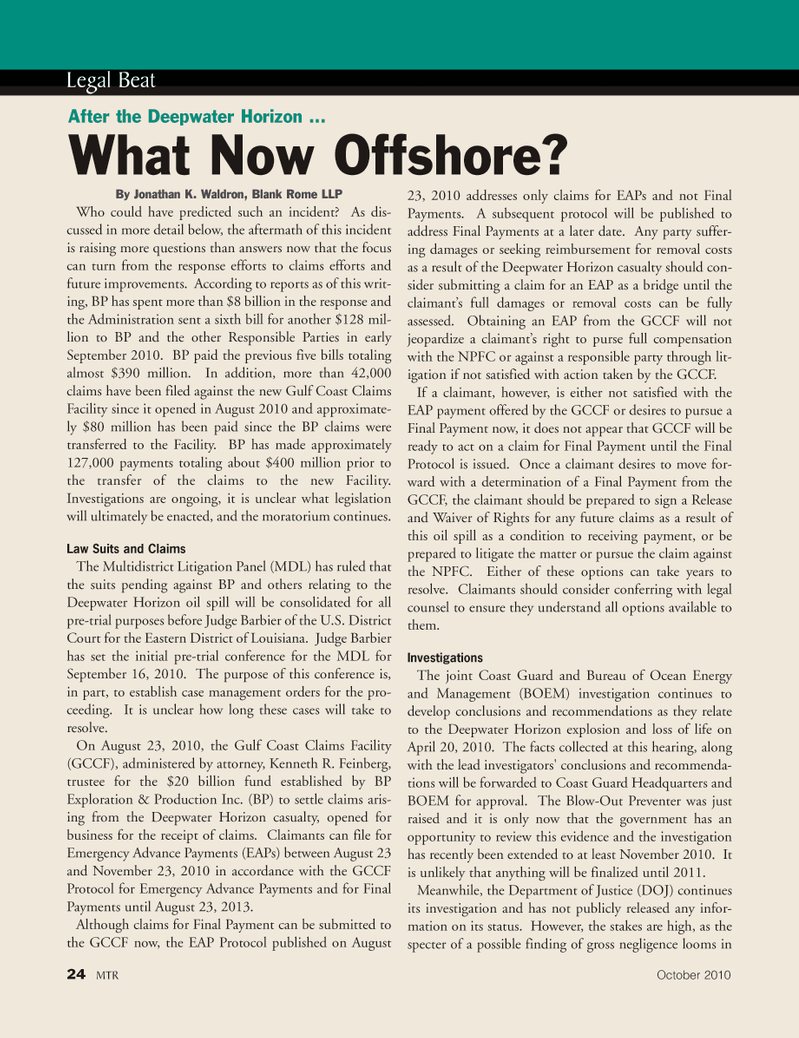
Page 24: of Marine Technology Magazine (October 2010)
Ocean Engineering & Design
Read this page in Pdf, Flash or Html5 edition of October 2010 Marine Technology Magazine
24 MTR October 2010
Legal Beat
After the Deepwater Horizon ...
What Now Offshore?
By Jonathan K. Waldron, Blank Rome LLP
Who could have predicted such an incident? As dis- cussed in more detail below, the aftermath of this incident is raising more questions than answers now that the focus can turn from the response efforts to claims efforts and future improvements. According to reports as of this writ- ing, BP has spent more than $8 billion in the response and the Administration sent a sixth bill for another $128 mil- lion to BP and the other Responsible Parties in early
September 2010. BP paid the previous five bills totaling almost $390 million. In addition, more than 42,000 claims have been filed against the new Gulf Coast Claims
Facility since it opened in August 2010 and approximate- ly $80 million has been paid since the BP claims were transferred to the Facility. BP has made approximately 127,000 payments totaling about $400 million prior to the transfer of the claims to the new Facility.
Investigations are ongoing, it is unclear what legislation will ultimately be enacted, and the moratorium continues.
Law Suits and Claims
The Multidistrict Litigation Panel (MDL) has ruled that the suits pending against BP and others relating to the
Deepwater Horizon oil spill will be consolidated for all pre-trial purposes before Judge Barbier of the U.S. District
Court for the Eastern District of Louisiana. Judge Barbier has set the initial pre-trial conference for the MDL for
September 16, 2010. The purpose of this conference is, in part, to establish case management orders for the pro- ceeding. It is unclear how long these cases will take to resolve.
On August 23, 2010, the Gulf Coast Claims Facility (GCCF), administered by attorney, Kenneth R. Feinberg, trustee for the $20 billion fund established by BP
Exploration & Production Inc. (BP) to settle claims aris- ing from the Deepwater Horizon casualty, opened for business for the receipt of claims. Claimants can file for
Emergency Advance Payments (EAPs) between August 23 and November 23, 2010 in accordance with the GCCF
Protocol for Emergency Advance Payments and for Final
Payments until August 23, 2013.
Although claims for Final Payment can be submitted to the GCCF now, the EAP Protocol published on August 23, 2010 addresses only claims for EAPs and not Final
Payments. A subsequent protocol will be published to address Final Payments at a later date. Any party suffer- ing damages or seeking reimbursement for removal costs as a result of the Deepwater Horizon casualty should con- sider submitting a claim for an EAP as a bridge until the claimant’s full damages or removal costs can be fully assessed. Obtaining an EAP from the GCCF will not jeopardize a claimant’s right to purse full compensation with the NPFC or against a responsible party through lit- igation if not satisfied with action taken by the GCCF.
If a claimant, however, is either not satisfied with the
EAP payment offered by the GCCF or desires to pursue a
Final Payment now, it does not appear that GCCF will be ready to act on a claim for Final Payment until the Final
Protocol is issued. Once a claimant desires to move for- ward with a determination of a Final Payment from the
GCCF, the claimant should be prepared to sign a Release and Waiver of Rights for any future claims as a result of this oil spill as a condition to receiving payment, or be prepared to litigate the matter or pursue the claim against the NPFC. Either of these options can take years to resolve. Claimants should consider conferring with legal counsel to ensure they understand all options available to them.
Investigations
The joint Coast Guard and Bureau of Ocean Energy and Management (BOEM) investigation continues to develop conclusions and recommendations as they relate to the Deepwater Horizon explosion and loss of life on
April 20, 2010. The facts collected at this hearing, along with the lead investigators' conclusions and recommenda- tions will be forwarded to Coast Guard Headquarters and
BOEM for approval. The Blow-Out Preventer was just raised and it is only now that the government has an opportunity to review this evidence and the investigation has recently been extended to at least November 2010. It is unlikely that anything will be finalized until 2011.
Meanwhile, the Department of Justice (DOJ) continues its investigation and has not publicly released any infor- mation on its status. However, the stakes are high, as the specter of a possible finding of gross negligence looms in

 23
23

 25
25
